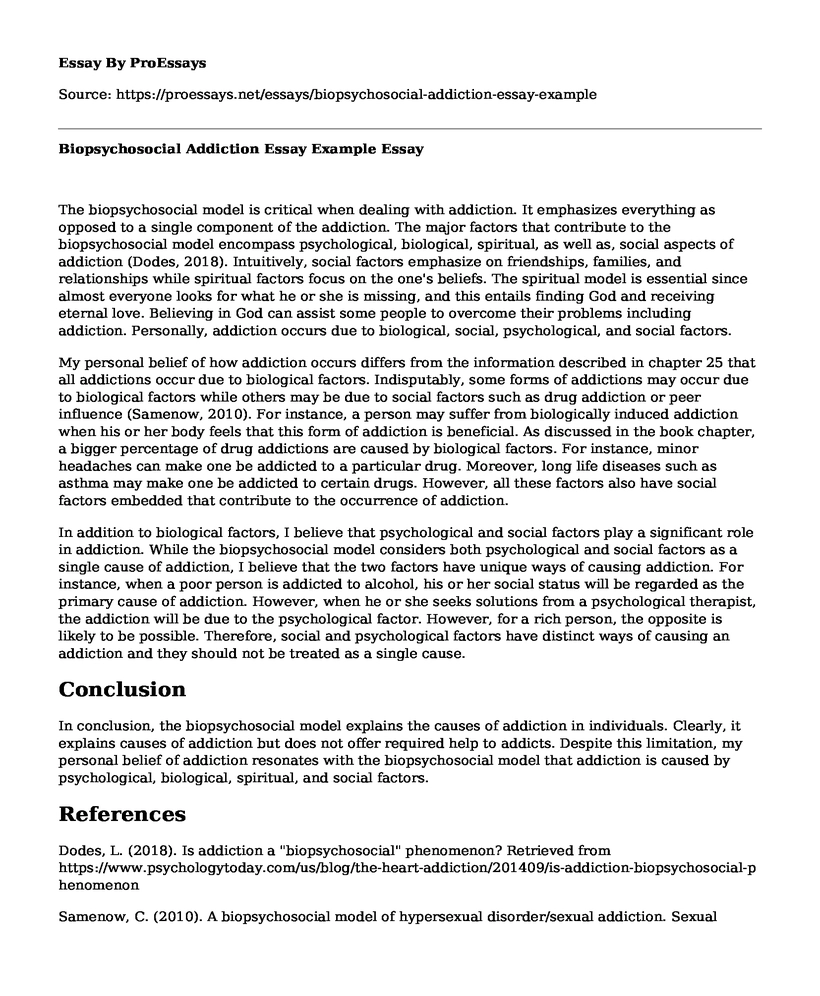The biopsychosocial model is critical when dealing with addiction. It emphasizes everything as opposed to a single component of the addiction. The major factors that contribute to the biopsychosocial model encompass psychological, biological, spiritual, as well as, social aspects of addiction (Dodes, 2018). Intuitively, social factors emphasize on friendships, families, and relationships while spiritual factors focus on the one's beliefs. The spiritual model is essential since almost everyone looks for what he or she is missing, and this entails finding God and receiving eternal love. Believing in God can assist some people to overcome their problems including addiction. Personally, addiction occurs due to biological, social, psychological, and social factors.
My personal belief of how addiction occurs differs from the information described in chapter 25 that all addictions occur due to biological factors. Indisputably, some forms of addictions may occur due to biological factors while others may be due to social factors such as drug addiction or peer influence (Samenow, 2010). For instance, a person may suffer from biologically induced addiction when his or her body feels that this form of addiction is beneficial. As discussed in the book chapter, a bigger percentage of drug addictions are caused by biological factors. For instance, minor headaches can make one be addicted to a particular drug. Moreover, long life diseases such as asthma may make one be addicted to certain drugs. However, all these factors also have social factors embedded that contribute to the occurrence of addiction.
In addition to biological factors, I believe that psychological and social factors play a significant role in addiction. While the biopsychosocial model considers both psychological and social factors as a single cause of addiction, I believe that the two factors have unique ways of causing addiction. For instance, when a poor person is addicted to alcohol, his or her social status will be regarded as the primary cause of addiction. However, when he or she seeks solutions from a psychological therapist, the addiction will be due to the psychological factor. However, for a rich person, the opposite is likely to be possible. Therefore, social and psychological factors have distinct ways of causing an addiction and they should not be treated as a single cause.
Conclusion
In conclusion, the biopsychosocial model explains the causes of addiction in individuals. Clearly, it explains causes of addiction but does not offer required help to addicts. Despite this limitation, my personal belief of addiction resonates with the biopsychosocial model that addiction is caused by psychological, biological, spiritual, and social factors.
References
Dodes, L. (2018). Is addiction a "biopsychosocial" phenomenon? Retrieved from https://www.psychologytoday.com/us/blog/the-heart-addiction/201409/is-addiction-biopsychosocial-phenomenon
Samenow, C. (2010). A biopsychosocial model of hypersexual disorder/sexual addiction. Sexual Addiction & Compulsivity, 17(2), 69-81.
Cite this page
Biopsychosocial Addiction Essay Example. (2022, Sep 22). Retrieved from https://proessays.net/essays/biopsychosocial-addiction-essay-example
If you are the original author of this essay and no longer wish to have it published on the ProEssays website, please click below to request its removal:
- Article Review Sample - Placebo Use in the UK
- Politics of Aids Policy Growth in South Africa Essay
- Which Tools Are Best When Assessing Pain in Dementia Patients
- Health Factors and Practices in Disaster and Emergency Situations Paper Example
- Gender Diversity in Business: Exploring Its Meaning and Impact - Research Paper
- Essay Example on Drug Use: Risky Behavior and Its Causes
- Essay Example Long-Term Care Facilities: At Risk During Flu Outbreaks







